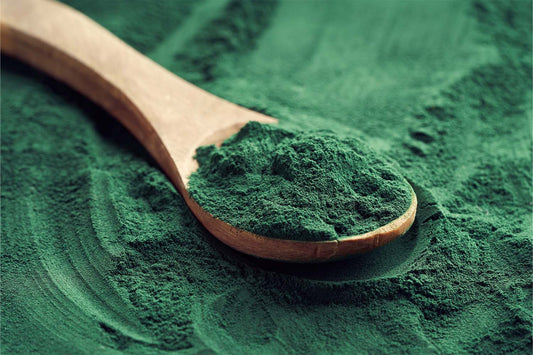Algae, with its impressive profile of vital nutrients, just may be the food of the future. As an abundant source of vitamins, minerals, fats, proteins, and more, algae make a great supplement to one’s diet. Whether you're a vegan, vegetarian, or keto dieter, algae can help you meet your nutritional needs in a sustainable way.
This potent source of vitamins and nutrients is highly underrated, primarily because its nutritional content is not widely known. However, there are a wide variety of species of algae, and each offers its own specific health benefits. If algae are not yet on your radar, then you just may be missing out on all that they have to offer.
At iwi life, we are proud to embrace the many powers of algae and share the benefits that it can provide as part of our daily nutrition.
What Is Algae?
Algae is an aquatic plant that performs photosynthesis and contains chlorophyll a and chloroplasts but does not have stems, true roots, or leaves like land plants. Despite this, algae are not only capable of surviving but also thriving in an array of environments. They can grow in both saltwater and freshwater, in hot springs, within snow, and even on rocks. This adaptability is one of the reasons why they play a crucial role in the ecology of our planet.
The term “algae” is often used very generally as many different protists can be grouped under the name. This grouping is due to the shared trait of photosynthesis, a process where sunlight is converted into energy. However, the world of algae is incredibly diverse, with Scientists estimating that there may be anywhere between 30,000 and one million species of algae, each with its unique characteristics and benefits.
Forms of algae can be either single-celled organisms or multicellular. Single-celled algae, or microalgae, can be found in both freshwater and marine environments. They can exist independently or as part of a colony. Multicellular algae, on the other hand, are often large and complex, forming structures like the seaweeds that you might see while walking along the beach.
These widespread organisms are fundamental to life as we know it. They produce around half of the oxygen in the Earth’s atmosphere. This means that every second breath you take, you can thank algae for it. This oxygen production is a byproduct of their photosynthesis process, which also absorbs carbon dioxide, helping to combat climate change. Between its oxygen production and the ability to harness sunlight to photosynthesize, algae is an eco-friendly powerhouse.
However, the potential of algae extends beyond oxygen production and carbon absorption. Algae serve as a primary food source for a multitude of marine species, highlighting its importance in the aquatic food chain. Furthermore, certain types of algae are rich in nutrients, making them a valuable source of food and supplements for humans.
Altogether, this super plant has tons of potential — but the potential of algae extends beyond oxygen production and carbon absorption. Algae serve as a primary food source for a multitude of marine species, highlighting its importance in the aquatic food chain. Furthermore, certain types of algae are rich in nutrients, making them a valuable source of food and supplements for humans.
What Are the Health Benefits of Algae?

These photosynthetic organisms are packed with nutrients and offer many great health benefits. Regular consumption of different groups of algae can help support various systems in the body, especially since algae has such a high nutrient density.
Omega-3 Fatty Acids
Omega-3 fatty acids are a form of polyunsaturated fats that exist in cells throughout the body. The three main types of omega-3 fatty acids are alpha-linolenic acid (ALA), docosahexaenoic acid (DHA), and eicosapentaenoic acid (EPA).ALA exists in a wide variety of foods, making it easy to receive enough of the nutrient on a daily basis. However, DHA and EPA are harder to obtain, meaning that many individuals benefit from supplementing these two fatty acids in their diet.
The most abundant dietary source of omega-3s is fatty fish, like salmon, mackerel, and tuna. Until recently, the only available supplements for omega-3 were based on fish or krill oil, but with the rise in the availability of algae, this has all started to change.
Algae is the only plant-based source of DHA and EPA omega-3 fatty acids, providing valuable nutrition for those on a plant-based diet or people who do not like fish.
Not only is algae the only plant-based source of the nutrient, but it also produces the most bioavailable form. This means that the omega-3 fatty acids available in algae are more easily absorbed by the body than any other source, even more so than the most common omega-3 supplements. The omega-3s in one type of algae, Nannochloropsis, are absorbed at least 1.7X better than those in krill or fish oil.
Amino Acids
Algae is extremely protein-rich, and as a result, it also contains an impressive amino acid profile. Amino acids, the building blocks of proteins, are most present in the cell walls of algae. Almost all edible algae contain the same forms of amino acids but in different amounts. This includes essential amino acids like leucine, isoleucine, and valine, which are vital for muscle growth and repair, as well as non-essential amino acids including alanine, glutamic, and aspartic acid, which play a role in immune function, neurotransmitter regulation, and antioxidant activity.
Algal species contain over a dozen amino acids, making them a comprehensive source of these critical nutrients. Amino acids are largely present in macroalgae, like seaweeds. Around 50% of the amino acids in seaweed are essential amino acids, meaning they cannot be produced by the body and must be consumed through diet or supplementation. Therefore, algae consumption is a great way to supplement amino acid intake and support the function of many important bodily systems.
Amino acids serve many important roles in the body, such as regulating food intake, supporting cell-to-cell communication through hormone production, and promoting the growth of bodily tissue. Other benefits of amino acids include supporting a healthy immune system, building muscle, wound healing and repair, energy production, and aiding digestion.
Antioxidants
Antioxidants are crucial for their ability to maintain cell health during exposure to free radicals. Free radicals are unstable molecules in the body that can form as a result of cell waste or factors like inflammation, UV exposure, and pollution. These harmful molecules can damage cells, proteins, and DNA, leading to various health problems. Free radicals in the body cause oxidative stress, which can harm cells and speed aging.
Antioxidants help support the health of the cells throughout your body, even during free radical exposure. This means they can work to maintain your health and wellness as a whole.
Great sources of antioxidants are fruits, vegetables, plant-based foods, and algae. Algae, in particular, are rich in several types of antioxidants, including carotenoids, chlorophyll, and phycobiliproteins, which have been shown to have powerful antioxidant properties.
Vitamin B12
Although algae are not natural producers of B12, they absorb a considerable amount of the nutrient from their environment. This unique ability to absorb and concentrate vitamin B12 makes algae a great source of the essential vitamin, particularly for individuals on a plant-based diet.
Vitamin B12 is important for supporting healthy brain and nervous system function, supporting energy, and even helping to support the number of red blood cells in your bloodstream. It is also essential for DNA synthesis and maintaining healthy nerve cells.
Many people are deficient in this crucial vitamin, especially when approaching old age or on a plant-based diet, so algae can be very beneficial to help supplement the necessary intake of B12.It's a convenient and easy way to ensure you're getting enough of this essential nutrient, regardless of your dietary preferences or restrictions.
What Are the Most Common Types of Algae?
Despite the thousands of species of algae, a few types are most well-known to humans, as they provide many great health benefits. Some have even been used by humans for centuries as both a fertilizer and food source. The following are the five most common, most nutritious types of algae.
1. Porphyra
Unlike chlorophyta (green algae), Porphyra is a type of red algae (rhodophyta) known for its unique pigments that forms an edible seaweed. This form of algae also makes nori, which is most known for wrapping sushi. Nori is a dark green sheet that is made by taking edible seaweed and pressing it into very thin sheets.
Although originally from Japan, Nori has become very popular worldwide and can be found in many stores as an enjoyable snack. Nori is not only great for holding together your sushi roll, but it is also packed with proteins, carbohydrates, and micronutrients. Porphyra’s combination of nutrients gives it antioxidant properties as well as the potential to support immune health and maintain healthy blood pressure.
Porphyra is also rich in iron, containing about 88% of the recommended daily intake per 100 grams. This iron is also more easily absorbed by the body than other sources.
2. Laminaria
Laminaria, similar to macrocytosis, is a type of giant kelp that’s part of the brown algae family found along the coasts of the Atlantic and Pacific oceans. This brown alga is different from other similar seaweeds like sargassum as it contains a wide variety of vitamins and minerals. Laminaria is used as food in many countries, especially in Japan, making a great addition to soups.
This type of kelp is highly nutritious, containing iodine, potassium, calcium, zinc, and iron. Laminaria has antioxidant properties and has also been used for centuries as a way to soothe intestinal discomfort. There is some science to back up this tradition as laminaria can help promote gut health by supporting gut barrier function.
Since it is so rich in iodine, Laminaria also helps to support healthy thyroid function. The kelp may also support immune function and act as a prebiotic.
3. Spirulina
Spirulina is a type of blue-green algae, or a form of prokaryotic cyanobacteria. Unlike euglena and other flagellates, Spirulina does not have a flagella to use for movement. Instead, this filamentous algae moves using a rapid rotating motion that looks similar to a corkscrew. Spirulina has been used for centuries because of its health benefits, and it is still a common ingredient in many nutritious foods today.
Just one tablespoon of spirulina can provide four grams of protein, making it a worthy addition to your diet. This edible cyanobacteria also includes vitamin A, vitamin B, minerals like calcium and iron, carotenoids, antioxidants, and more. Spirulina is also the most abundant source of omega-6 fatty acids compared to all other algae forms.
Spirulina can be added to smoothies, energy bars, juices, and more, but it is often taken as a supplement in tablet, capsule, or powder form.
The health benefits of spirulina are plentiful, which is why many refer to this green stuff as a superfood. Research shows that spirulina's antioxidants and zinc content can help support your immune system. Regular intake of spirulina has the potential to help maintain normal levels of cholesterol. Spirulina may also help support your energy levels and potentially support your mood.
4. Chlorella
Chlorella, another type of cyanobacteria, is also part of the blue-green algae family and grows in freshwater. This blue-green alga is produced on a large scale and used as a nutritional supplement.
Like spirulina, chlorella is also a great source of nutrients. Chlorella is packed with organelles, proteins, omega-3 fatty acids, vitamins, minerals, and antioxidants. Chlorella can contain 70% dry weight protein and even has an amino acid content comparable to eggs, demonstrating just how highly nutritious this type of freshwater algae is.
Chlorella is rich in vitamin B12 and iron, making it a great supplement for anyone on a plant-based diet. Chlorella may just be one food of the future, providing such a high concentration of nutrients in such small amounts, but for now, this cyanobacterium makes for a great supplement. It is often found in liquid, powder, or tablet form and can be added to salad dressings, smoothies, baked goods, and more.
The nutrient density of chlorella means that it produces many health benefits. One of chlorella's most notable possible health benefits is its ability to support cognitive function during aging, including memory and motor skills. This is likely due to the large number of antioxidants that exist in chlorella. Since it is rich in a range of vitamins and nutrients, this futuristic superfood can also support a healthy immune system.
5. Nannochloropsis

Nannochloropsis is a microalga and type of phytoplankton that is related to brown algae. This microalga plays a crucial role in absorbing carbon dioxide and can be found in both freshwater and marine ecosystems. Unlike diatoms, Nannochloropsis doesn’t have a silica shell, but like diatoms, it plays a crucial role in the food chain as it’s a food source for plankton. Nannochloropsis has been used for decades in research into alternative energy. Today, the benefits of Nannochloropsis for human supplementation are more widely embraced.
Like other algae products, Nannochloropsis contains considerable amounts of amino acids and omega-6 fatty acids. Nannochloropsis is also the most abundant source of carotenoids amongst other forms of microalgae, providing it with strong antioxidant capabilities.
This species of algae contains some of the highest amounts of omega-3 out of any of the other species and is particularly rich in EPA. Nannochloropsis contains 100 times more EPA than other microalgae, making it a great supplement for this important fatty acid. With such high amounts of EPA omega-3 fatty acids, Nannochloropsis is highly beneficial in supporting heart health by helping to maintain healthy blood pressure and cholesterol levels already in the healthy range. EPA is also beneficial for supporting emotional wellness.
Nannochloropsis is the foundation for the iwi life omega-3 supplements. We produce this alga in desert habitats using sunlight, saltwater, and CO2. iwi life produces this species of algae using highly sustainable methods, making it a great alternative to other less-sustainable forms of omega-3s like fish or krill.
See the Health Benefits of Algae for Yourself
Ultimately, with its high nutrient density, algae has a long list of health benefits. Containing large amounts of protein, B vitamins, and omega-3 fatty acids, it is great for supporting multiple systems in your body. Discover just how much the different types of algae can benefit you and your overall health by including an algae supplement as part of your daily routine. iwi life algae-based omega-3 supplement is a great place to start.
At iwi life, we produce vegan algae-based omega-3 supplements that are specially formulated to provide you with the nutrients you need. Our Omega-3 supplement harnesses the power of omega-3 fatty acids for whole body support.* Explore our whole family of products to see how omega-3 can support your health.
Source:
HOW MANY SPECIES OF ALGAE ARE THERE? | PubMed Central
Algae as nutritional and functional food sources: revisiting our understanding | PubMed Central
Chlorella: Nutrition and possible health benefits | Medical News Today
(PDF) Health Benefits and Pharmacological Effects of Porphyra Species | Research Gate















